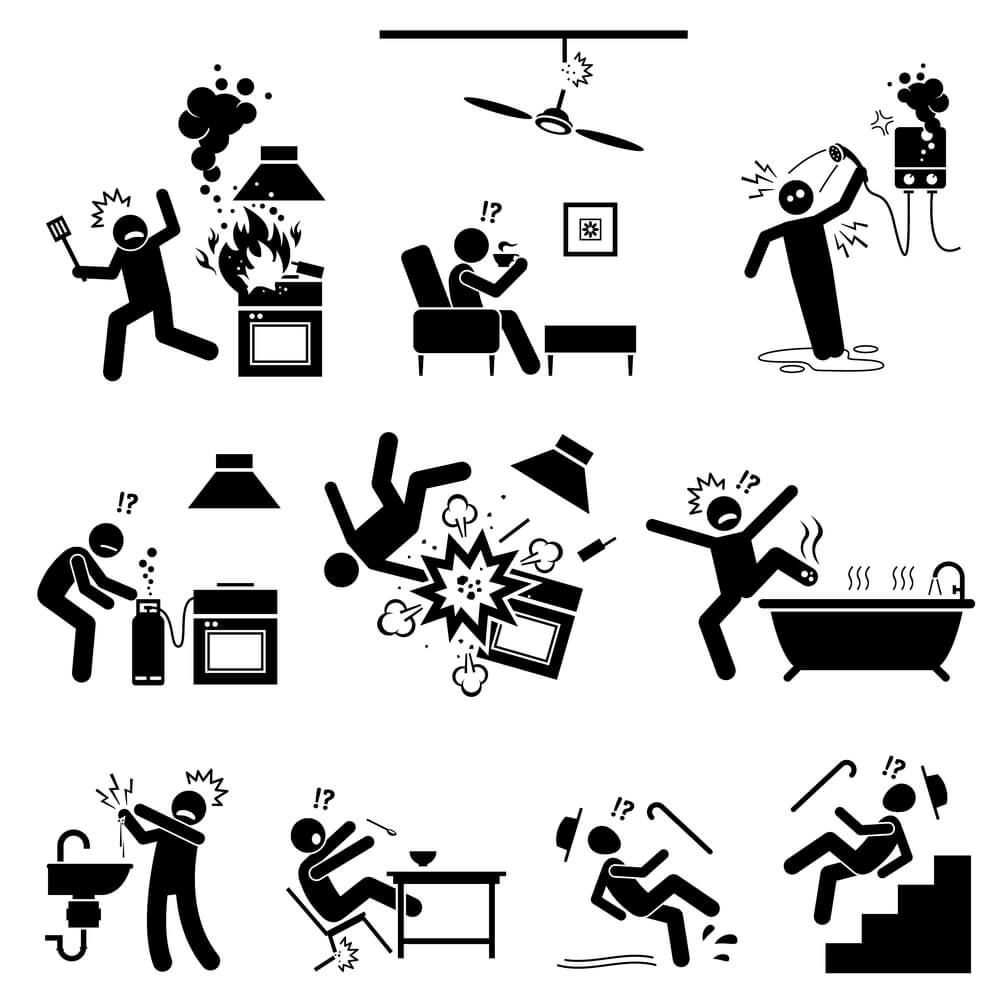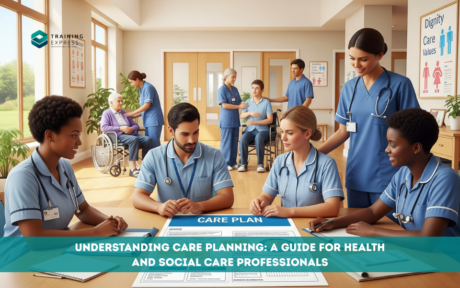

A kitchen hazard is a danger or risk that may cause injury, illness, or damage in a kitchen environment. Some examples are sharp knives, hot stovetops, slippery floors, and exposure to chemicals. Other kitchen hazards may include improper food handling, poisoning, or contamination. It is essential to become aware of these hazards. And take appropriate food hygiene and safety precautions to prevent accidents in the kitchen.
Table of Contents
Why you should be careful in the kitchen
Several reasons why one should be careful in the kitchen:
Safety
A kitchen is full of potential hazards. For example, it contains sharp knives, hot stovetops and ovens, and slippery floors. These kitchen hazards can cause serious injury if not handled properly.
Health
Improper food handling can lead to food poisoning or contamination, which causes illness.
Fire
Cooking equipment such as stoves and ovens can be a fire hazard if used incorrectly.
Property damage
Kitchen fires or spills can cause damage to the property.
Efficiency
Being careful and organised can help to save time and avoid mistakes while cooking.
Therefore, become aware of the potential risks and take appropriate precautions. Follow food hygiene and safety to prevent accidents and maintain a safe and healthy kitchen environment.
What are the dangers in a kitchen?

Several dangers can be present in a kitchen, some of which include:
Sharp objects
Knives, graters, and other sharp objects can cause cuts if not handled properly.
Heat sources
Stovetops, ovens, and other heat sources can cause burns. If not used correctly or if hot surfaces are touched accidentally.
Slips, trips and falls
Spill liquids or dropped food can make the kitchen floor slippery. As a result, it increases the risk of slips, trips and falls.
Fire
Cooking equipment such as stoves, ovens, toasters, and microwaves can be a fire hazard. If not used correctly or if left unattended.
Chemicals
Cleaning products and chemicals can irritate and cause allergic reactions if they are not stored or used correctly.
Food safety
Improper food handling can lead to food poisoning, which can cause illness.
Electrical hazards
Faulty equipment, improper use and damaged wiring cause electrical shocks, fires etc.
In other words, be aware of these kitchen hazards and take appropriate precautions to prevent accidents. Also, keep the kitchen clean and well-maintained to reduce the risk of accidents. The food hygiene and safety course outlines the common risks of handling food in a kitchen.
Are you looking to improve your understanding of kitchen hazards, food safety, and hygiene?
This Food Hygiene and Safety Level 3 Course is designed specifically for you. Provide you with the skills, credentials and practical knowledge. In order to, ensure food safety and hygiene in your workplace.
Most importantly, learn how to identify, understand, manage kitchen hazards and supervise food safety. Also, implementing a food safety management system can minimise food hazard risks.
Gain in-depth knowledge of food hygiene best practices and kitchen hazards.
17 kitchen hazards and how to avoid them:

The most common kitchen hazards include slips, trips, falls, burn hazards, knife injuries, and food contamination. These hazards can occur due to various factors, such as poor kitchen layout, lack of proper training, and failure to follow safe food handling practices.
1. Knife injuries
Be careful before using sharp knives and maintain them regularly, use a cutting board, and keep your fingers away from the blade while cutting. Follow these to avoid knife injuries in the workplace.
2. Burns
It is essential to use oven mitts and potholders to avoid burns. Also, keep loose clothing and long hair tied back.
3. Chemicals
You can avoid chemical hazards by storing them in their original labelled containers and away from food, using appropriate personal protective equipment, and following the manufacturer’s instructions.
4. Improper handling of kitchen equipment
Follow the manufacturer’s instructions and only use the equipment for its intended purpose. Improper handling of kitchen equipment can also cause kitchen hazards.
5. Slips, trips, and falls
To avoid slips, trips, and falls, it is important to keep the kitchen floor clean and dry, use non-slip mats, and always be aware of your surroundings.
6. Head and eye injuries
To avoid head and eye injuries, wearing appropriate head and eye protection when working in the kitchen is important.
7. Crowded workspace risks
Keeping the kitchen clean and organised and the aisles and walkways clear is important.
8. Lifting injuries
Avoid lifting injuries, use proper lifting techniques and ask for help when lifting heavy items.
9. Fire hazards
It is important to keep the kitchen clean and free of clutter and not leave cooking food unattended.
To avoid kitchen fires, keep flammable materials away from heat sources, and have working smoke detectors in the kitchen.
10. Electric shock
Use appliances and equipment safely to avoid electric shock. And it is important to avoid using appliances near water.
11. Overloaded circuits
Avoid overloaded circuits. Remember not to plug only a few appliances into one outlet, to use power strips with surge protection, and to unplug appliances when not in use.
12. Improper storage
Keep food stored at the correct temperature, label and date all food, and use appropriate storage containers.
13. Food poisoning
It is important to avoid food poisoning by handling food safely, keeping raw and cooked food separate, and cooking food to the correct temperature.
14. Broken glass
Handle glassware carefully, use appropriate containers for glassware, and dispose of broken glass properly.
15. Loose clothes and hair
It is important to tie back long hair, tuck in loose clothing and avoid wearing jewellery or other loose accessories in the kitchen. Because loose hair, clothes and jewellery can easily get caught in machinery, burners or other kitchen equipment, resulting in accidents or injuries.
16. Dirty sponges
To avoid cross-contamination, regularly clean and sanitise sponges. Also, use separate sponges for different tasks, and replace sponges when they become frayed or worn.
17. Thawing food
Avoid bacterial growth and cross-contamination. It is important to thaw food in the refrigerator, in cold water, or in a microwave. On the other hand, never thaw food at room temperature.
Recovering from kitchen hazards

Recovering from kitchen hazards that have already occurred will depend on the specific situation. However, some general steps that can take include:
Prioritising Safety
The first step is to ensure that everyone in the kitchen is safe and that any ongoing hazards are immediately addressed. However, this may include calling emergency services if necessary.
Assessing the damage
Once safety has been established, assess the extent of the damage caused by the hazard. Thus, it will help you determine the next steps to take.
Cleaning and sanitising
Suppose there has been a spill or other type of contamination. In that case, it is important to clean and sanitise the affected area to prevent the spread of bacteria or other harmful substances.
Documenting the incident
It is important to document the incident, including what happened, when it happened, who was involved and any actions taken to mitigate the hazard. You can use this information to improve safety procedures in the future.
Reviewing and updating safety procedures
After kitchen hazards have occurred, it is important to review the safety procedures and make necessary changes to prevent a similar incident from happening again.
Notifying the relevant authorities
Depending on the severity of the incident, it may be necessary to notify relevant authorities, such as the local health department, OSHA, or insurance company.
Providing support
After kitchen hazards have occurred, it is important to provide support to those who have been affected. Including offering counselling services or other forms of support to help employees cope with the incident.
Resuming normal operations
Once the kitchen has been cleaned and sanitised, and any necessary repairs have been made, it is important to resume normal operations as soon as possible to minimise disruptions and financial losses.
FAQ
What is the most common kitchen hazard?
The most common kitchen hazard is slips, trips, and falls. But, this can occur due to various factors, such as spills, poor kitchen layouts, or cluttered walkways. Other common kitchen hazards include burn hazards from hot surfaces or equipment, knife injuries, and food contamination. These kitchen hazards can occur due to a lack of proper training, failure to follow safe food handling practices, and poor maintenance of kitchen equipment.
How to minimise hazards in the kitchen:
Introduce a reporting system
Encourage employees to report hazards as soon as they spot them. This way, potential hazards can be addressed and prevented before they cause an accident.
Implement a routine
Establish a routine for cleaning and maintaining kitchen equipment. It can reduce the hazards caused by dirty or malfunctioning equipment.
Use safety gear
Ensure employees wear safety gear such as non-slip shoes, oven mitts, and aprons to protect them from hazards.
Train employees
Provide regular training to employees on safe food handling and kitchen safety practices so they know the kitchen hazards and how to prevent them.
Proper food storage
Properly store food to avoid cross-contamination, ensure food is at the correct temperature, and use appropriate storage containers.
Keep the kitchen clean.
Keep the kitchen clean, organised, and free of clutter to reduce the risk of accidents and injuries.
Properly maintain equipment
Regularly maintaining and inspecting kitchen equipment can reduce hazards caused by malfunctioning or dirty equipment.
Properly label food
Properly label and date all food. So that, food can be properly rotated and used before its expiration date.
Be aware of the hazards.
Be aware of your surroundings always and the hazards that may be present in the kitchen.
Follow the food safety regulations.
Follow the food safety regulations and guidelines to avoid food poisoning and other kitchen hazards associated with food.
Have emergency plan
Have an emergency plan and ensure that all employees are familiar with it. Moreover, they know what to do in an emergency.
Food Hygiene and Safety should be mandatory amongst anyone who handles edible goods regularly, whether they work professionally inside restaurant kitchens or casually prepare dinner now and then back home. Either way, following the strict guidelines outlined here, will help reduce chances of hazardous incidents occurring whilst ensuring everyone’s meal remains free of contaminants, along with tasting delicious each time served up afterwards too!
- Available Courses
- Law10
- IT & Software225
- Design28
- Training6
- Accounting & Finance Primary48
- Teaching & Academics Primary36
- Teaching22
- Quality Licence Scheme Endorsed160
- Healthcare169
- Animal care10
- Job Ready Programme52
- Charity & Non-Profit Courses28
- HR & Leadership4
- Administration & Office Skills2
- Mandatory Training36
- Regulated Courses4
- Health and Safety520
- Marketing38
- Career Bundles201
- Construction59
- Electronics31
- Hospitality28
- Health and Social Care289
- Child Psychology40
- Management423
- Business Skills292
- First Aid73
- Employability283
- Safeguarding79
- Food Hygiene116
- Personal Development1597

 Food Hygiene
Food Hygiene Health & Safety
Health & Safety Safeguarding
Safeguarding First Aid
First Aid Business Skills
Business Skills Personal Development
Personal Development




